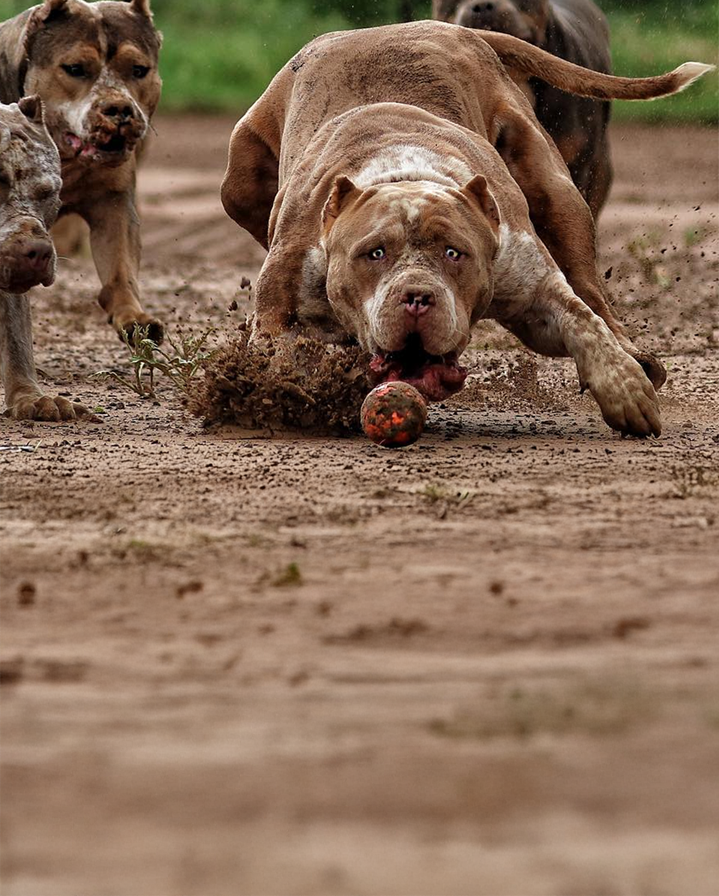How to Break Up a Dog Fight and How to Prevent Them
Pit bulls are a loyal and loving breed of dog with countless good qualities. And as a proud owner of this wonderful breed, it’s your responsibility to keep your dog—and other dogs in the area—safe and happy.
In order to do that, it’s important to take the proper steps to prevent dog fights.
In the right circumstances, all dogs will fight. But pit bulls fights can be more frequent and more severe if you don’t know how to prevent them.
A dog fight might sound scary, but the truth is that you can easily prevent them by making a few smart decisions. And if a fight does break out, you can break it up quickly as long as you know what to expect and how to react.
A Few Things You Need to Understand About Pit Bulls
- Pit bulls were bred for fighting. This doesn’t make them mean, bad, or evil; it’s just their heritage (similar to how many other dogs are bred for hunting).
- Other dog breeds will act out submission signals when they want to stop fighting, which usually signals the end of the fight. But pit bulls may ignore these signals, which means that a pit bull fight can lead to serious damage—or worse—if the fight is not broken up.
- Pit bulls are “people” dogs. They love spending time with people and enjoy attention and love from your family. They do not need another dog around to be happy.
What Causes Dogs to Fight?
- Dog fights can happen suddenly and without warning. Fights may be preceded by growling, barking, or posturing, but they may not be. Fights can even occur between dogs that have been close friends for years. And once two dogs have fought before, they are more likely to fight again in the future.
- Fights can be triggered by seemingly innocent causes, such as excitement and stimulation from seeing a squirrel or other small animal run by. Fights can also escalate from rough-housing, competing over a toy, or even out of jealousy (for example, if one dog is getting more attention from the family).
- Sexual hormones can cause dogs to behave much more aggressively than normal.
- Finally, tension between dogs can cause them to fight. And one sure source of tension is an unclear pecking order. If you have a fighting breed of dog, make sure to train it properly so that it clearly understands its place in the social hierarchy.
How to Prevent Dog Fights
The #1 best way to prevent dog fights in your home is to make the pit bull your only pet. As we mentioned above, pit bulls are “people dogs” who enjoy spending time with your family and do not need another dog to be happy.
If there’s no other dog around, there’s no one for your pit bull to fight with.
If you prefer to have more than one dog, here are 8 tips to minimize any chance of fighting:
- Get one male and one female. Same-sex dogs are more likely to fight. Two males (or two females) are much more likely to fight than a male and a female. This is true of every breed, not just pit bulls, because two dogs of the same sex are likely to see each other as rivals.
- Release pent-up energy by exercising your dogs. If dogs are not exercised frequently enough, they will build pent-up energy. This can lead to dog fights.
- Walk your dogs together. Walking your dogs together forms a stronger pack. Dogs that have formed a strong pack are less likely to fight.
- Spay or neuter your pit bulls as early as possible. Sexual hormones cause them to be much more aggressive than usual.
- Never leave your pit bull unsupervised with other animals. If you aren’t around to watch them, each pit bull should be crated or kept in a separate room.
- Watch your dogs when they are playing. Even innocent rough-housing can escalate into a fight if you aren’t paying attention. Remember, as the human you are the leader of the pack—it’s your job to set limits on the dogs’ behavior.
- Pick up dog toys, bones, and food when they’re not being used. Two dogs who stumble across a toy or a bone could start fighting over it.
- Always keep your pit bull on a leash when you take them for a walk, and keep them away from other unleashed dogs. This means that you should NEVER bring an adult pit bull to an off-leash dog park.
What If A Fight Does Break Out?
If your dog does start fighting, it’s important not to panic. Screaming and panicking will not stop a fight, it will only intensify it. By staying calming and using the proper tools, you can break up the fight quickly.
How to break up a dog fight, Method 1:
The two things you will need are a break stick (to pry the dog’s mouth open) and a collar or leash (to pull the dogs apart). It's important to keep collars on your dogs at all times. Breaking up a dog fight is more difficult when the dogs are not wearing collars.
A break stick is a stick you insert between the dog’s back teeth. Then, twist the stick to pry the dog’s mouth open.
Once the dog’s mouth is open and the hold is broken, grab their collars or leashes and pull UP. Avoid pulling them apart face to face at ground level, it will only make them fight more intensely. Separate the dogs as quickly as you can—by putting them in separate rooms, or tying one to a tree while you remove the other.
How to break up a dog fight, Method 2:
One of the FASTEST and SAFEST way to break up a dog fight is by grabbing both dogs by their collars and holding them in in the air as high as possible, so the dogs lose oxygen. Without oxygen, they will not be able to hold their grip.
Yes, one dog will usually lose oxygen before the other, but as long as both dog's front feet are off the ground and the collar is applying direct pressure to bottom of neck (as high up on neck as possible) they WILL lose oxygen and release their grip.
Do not hold the dogs in the air ANY longer than necessary — and that is the moment the dog releases its grip.
NEVER scold or hit your dog after a fight. Speak quietly to the dog to sooth it and reduce the arousal level. After the fight is over, it's important that you create peace, harmony, and balance.
The idea of a dog fight might sound scary, but as long as you follow this advice you shouldn’t have anything to worry about. Just be mindful of your dog’s heritage, and you’ll have a loving family member who will be a source of happiness for years to come.









138 comments
We are having the same issue with our two females. They’re both around 4 years. A trainer said they’re kind of going through doggie menopause and trying to establish dominance. Could also be protecting boundaries. Ours have had 4 fights since April. The last one was almost two weeks ago while our neighbor was over and they accidentally got out together. It was really bad. Trixie had to go to the ER vet because Coba tore muscles in Trixie’s armpit area. She had to then spend 9 days at our vet so they could take care of her. $2400 later, Trixie is back home and has a HUGE open wound still. I’m nervous about their future together once Trixie is healed.
Wow, after reading this I am a bit scared. I don’t want my dogs to be fighting at all. Just the thought of someday seeing blood terrifies me.
When we got the Pitt, we actually got 2, 1 male and 1 female. After a few days we really had to make a decision based on what the vets office said, it would be better to keep the male and not the female. So we decided on the male and gave the female to the vet to find a good loving home with the right family. Now, I’m wondering if we should have kept the female instead!!
I have a 3 year old Male Rottweiler, he’s also a medical service dog for my daughter, she’s 18. I also have a 4 month Male Pitt Bull. They bark and play off and on each day, and yes with supervision. They seem to love playing tug with an old sock. The puppy is all over the place playing with him. The puppy also likes to grab the Rottweilers collar while playing. They have never drawn any blood but at times I believe that the Rottweiler has had enough, not any biting, just sincere barks. Then we usually make them stop and rest an hour or so. Are we doing this right?
The pit puppy sleeps in the bed with my daughter and the Rottweiler sleeps on the floor in her room also.
This concerns me!!
I’m looking for some advice please. I have a two year old male pitty. I have the opportunity to add a female pitty pup to the family. I really don’t want my decision to blow up in my face of what I’ve red in this article. Any advice please.
Hi there, I hope that since you posted this, nothing has gotten worse. I am writing bc I have two 5yr old pits, 1 male, 1 female. They live seperated and i understand the reason for the fights.
We have split the house previously, and it is securely gated to manage the 2 aggressive dogs. They have been in the same house, for 3 years, Taco came with me, Bella is the bfs female. The bf now is away from the house for overnight and Bella has jealousy issues as well as anxiety, and Taco has slept with me since he was 4 wks old where Bella slept with the bf but is now lonely.
They got at each other through a one foot thick barricade, and it was vicious and terrifying. bf is the ‘alpha’ and both dogs know it and submit to him, he was not here. Since his night absence, it has gotten worse between them and today it was a 7 min fight and both of them are hurt and I am handling their medical to help them heal. Serious injuries.
If someone can please tell me what behaviors I need to change to correct this? They get roughly 2 hrs each of outdoor time with me in the day.
I have never heard any positives of having sibling pits together